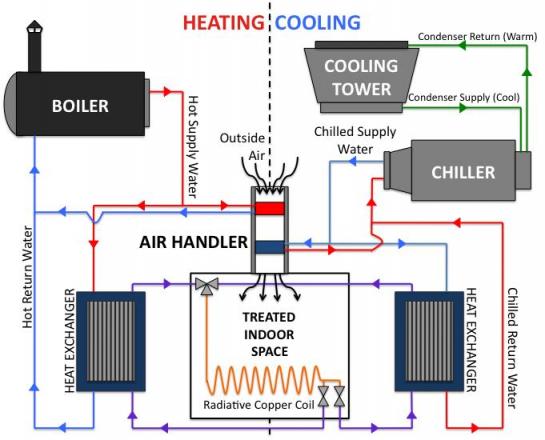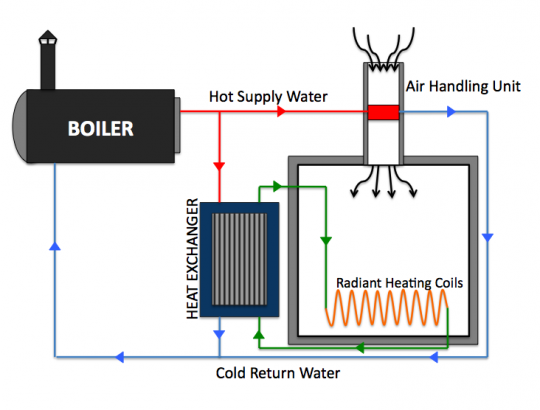Building Sustainability into Control Systems > HVAC & Controls
Introduction
Controls
Heating System
Cooling System
Introduction
In most buildings, indoor air temperature, humidity, and quality are maintained at comfortable levels using a Heating, Ventilation, and Air Conditioning (HVAC) system. The HVAC system at Cooper Union’s 41 Cooper Square academic building is centered on a hybrid strategy of heating and cooling. Throughout the space, proper air temperature and humidity conditions are maintained using both radiant panels and an array of air-handling units. Using the two systems in conjunction, the building can be cooled, heated and ventilated more efficiently than with a traditional HVAC system that utilizes forced air handling units alone. The Building Management System (BMS) is a computer-based control system that monitors and controls the operation of the HVAC system, employing various algorithms to meet the building’s heating, cooling, and ventilation needs. Figure 1 shows a schematic of the heating and cooling systems.

>Heating System:
Two natural gas boilers produce hot water in 41 Cooper Square. This hot water supply is routed to both the air-handling units and plate and frame heat exchangers. In the air-handling units, the water passes through heating coils over which treated air is blown, effectively heating the flow of air through forced convection. The warm air produced by the air-handling units is subsequently routed to designated rooms.
The heat exchangers transfer heat from the primary hot water produced by the boilers to a secondary hot water flow. This secondary flow is circulated through the radiant panels and floors around the building, heating the space through natural convection and radiation.
>Cooling System:
Two large chillers produce cold water for the building. The chillers operate on a standard vapor compression cycle. The primary chilled water supply produced by these chillers is routed to both air-handling units and a plate and frame heat exchanger which chills water for the radiant floors and panels. The air-handling units use forced convection to supply cold air to indoor spaces throughout the building. The radiant panels cool the indoor space through natural convection with air and radiation.
The building also has a cogeneration plant, also known as a combined heat and power plant, which when operating, produces heat and reduces the load on the boiler.
Controls
>Building Management System (BMS):
Throughout the year, the heating and cooling systems are used simultaneously to maintain conditions inside the building within desired set points. The BMS uses a large array of sensors, like thermistors and differential pressure gauges, to monitor temperature and humidity conditions throughout the building and to control the operation of all the HVAC equipment. Using the data collected by the sensors, the BMS outputs appropriate control signals to the HVAC system’s numerous actuators, such as Variable Frequency Drives (VFDs) and actuating valves, in order to control the indoor air conditions. The BMS has advanced integrated control features, such as a Cooling Plant Optimization Package , Enthalpy Switchover System , Temperature-Compensated Duty Cycling , and Peak Demand Limiting Program to reduce the amount of energy consumed by the building while meeting all standards of indoor comfort and air quality.
>HVAC Control Systems Terminology:
It is important to understand HVAC control systems terminology before continuing into HVAC systems in detail. Figure 2 contains an illustration of a basic HVAC control system. Warm air flows through a finned-tube cooling coil, where heat is transferred from the air passing over the tubes and fins to the water flowing through the tubes [1]. A valve is used to vary the amount of chilled water flowing through the coil and, therefore, the cooling capacity of the coil. This basic control system includes a process or plant, a controlled variable, a sensor, a controller, a controlled device, and a controlled agent.

These terms are defined below, referencing the open-loop and closed-loop systems in Figure 3 [1]:
- The plant is the system or process being controlled. In this case, the plant is the air conditioning system with finned-tubed cooling coil.
- The controlled variable or process variable is the parameter being measured and controlled. In this example, the controlled variable is the temperature of the air leaving the cooling coil.
- The sensor measures the condition of the controlled variable and sends an input signal to the controller. In this example, the controller input is the signal from the temperature sensor located in the airflow exiting the coil.
- The controller is the brain of the system. It compares the measured condition of the controlled (or process) variable to the desired condition (set-point), and transmits a corrective output signal to the controlled device. In this example, the controller output is a 0 to 100% signal to the actuating valve.
- The controlled device or actuator is the component that reacts to the output signal from the controller and takes action to vary the controlled agent. In this example, the controlled device is the actuating valve.
- The controlled agent is the medium that is manipulated by the controlled device. In this example, the controlled agent is the chilled water. As the valve opens, chilled water is allowed to flow through at a higher rate.
>Types of HVAC Control Systems
A control system be either open-loop or closed-loop. In the open-loop system shown in Figure 3, the controller sends a signal to the actuating valve, based on outdoor air temperature, but there is no feedback to the controller as to the resulting temperature of the air leaving the coil. In open-loop control, the designer assumes that there is a fixed relationship betweeen outside air temperature and the building's heating requirement, and specifies control action based on the outdoor air temperature. In the closed-loop system in Figure 3, the controller compares the temperature of the air leaving the coil to the desired set-point and adjusts the valve to achieve the desired temperature [1].

Block diagrams of the open-loop and closed-loop systems are shown in Figures 4 and 5, respectively.


Most modern, high performance HVAC systems used closed-loop feedback control. The closed-loop control system has several sensors, such as thermostats and humidistat. The temperature and humidity are controlled variables on this system. The control system must keep the occupied zone's controlled variables within a specified range.
Heating System
The heating system in 41 Cooper Square utilizes two methods of heating. First, it passes hot water through copper coils situated in floors and ceilings all around the building to heat indoor spaces through natural convection and radiation. Second, hot water is provided to the air-handling units where it heats the flow of air recirculated and entering the building, which is distributed throughout the building in ducts and variable air volume (VAV) units. Figure 6 illustrates 41 Cooper Square’s dual system of heating.

This figure shows that the heating system utilizes two separate flows of water to operate the air-handling units and radiant panels. The Primary Flow is the hot water that is produced by the hot water heaters. This flow is routed directly to the system’s air handling units. Once in the air handling unit, the water is passed through a series of coils that heat the incoming air. The primary flow is also routed to a plate and frame heat exchanger, where it is used to heat a Secondary Radiant Hot Water Flow which is pumped through the building’s radiant floors and ceiling panels.
Cooling System
A primary method of cooling in the 41 Cooper Square building consists of radiant ceiling panels. Chilled radiant water is passed through copper coils situated throughout the building, absorbing heat through natural convection and radiation. Water has a much higher specific heat than air1, and thus can absorb more thermal energy per unit mass. Consequently the use of water as a working fluid allows 41 Cooper Square to meet cooling loads more efficiently. However, it is still necessary to provide fresh air to all indoor spaces. Air is drawn from outside and treated in air- handling units. Inside these units, the flow of fresh air is cooled to a desired temperature before being sent to offices and classrooms. The overall cooling system with both the radiant heating and air-handling components is illustrated in Figure 7.

The schematic shows that the cooling system consists of three separate water flows. The building’s two chillers produce the primary flow. This chilled water supply is routed to a header, which provides secondary chilled water to the air-handling units and radiant chilled water heat exchanger. In the air-handling units, the water is passed through various coils and radiators to cool and dehumidify air used for indoor ventilation. At the plate and frame heat exchanger, heat is absorbed by the secondary chilled water flow to cool the radiant chilled water flow, which is pumped through the building’s radiant floors and ceilings. As it passes through these panels, the water absorbs heat before it is cooled again at the heat exchanger. Finally, the chiller’s vapor-compression refrigeration cycle requires that the refrigerant be condensed from a vapor to a liquid. In order to achieve this phase change, evaporative cooling towers provide water with which to cool the refrigerant. The flow of cold water produced by the cooling towers is called the condenser water flow.
Some spaces in 41 Cooper Square are cooled through forced air conditioning alone due to condensation concerns with the radiant ceiling panels. If the copper tubing in the ceiling panels is too cold, moisture in the air could condense on its surface and drip down to the floor below. The BMS control system is designed to minimize the likelihood of condensation (by supplying chilled water to the radiant panels above the dew point temperature). Nonetheless, sensitive areas such as computer and laboratory spaces are not fitted with radiant cooling systems to protect expensive equipment from the risk of water damage due to inadvertent condensation. This is one reason the windows in 41 Cooper Square must remain closed so that proper humidity levels throughout the building can be maintained to minimize condensation risks.
[1] "One of the Systems Series." HVAC System Control. Trane, 2002.
1The specific heat of water is 4.2 KJ/Kg*K while that of air of is 1.0 KJ/Kg*K
The Cooling Plant Optimization Package is a group of control algorithms that monitor and manage the cooling system in 41 Cooper Square. These algorithms modulate the operation and power consumption of cooling equipment, such as centrifugal chillers and cooling towers, to meet the building’s HVAC demands in an efficient manner. Reference: Cooling Plant Optimization: Application Guide, Rev. 3, Siemens Building Technologies Inc., Munich, Germany, 2003.
The Enthalpy Switchover System allows air-handling units with re-circulation systems to automatically recognize when ambient conditions are such that outside air alone can be used to meet the building’s cooling demands. In essence, sensors inform the BMS when the outside air enthalpy falls below the return air enthalpy, and subsequently operates the AHU with 100% outside air. Reference: GMP Set - The New Academic Building of Cooper Union – Building Management System. Syska Hennessy Group, New York, NY, 2007.
Temperature-Compensated Duty Cycling regulates the operating schedule of HVAC equipment to reduce the building’s power consumption during peak hours, when electricity rates increase. For example, the chillers are powered on prior to office hours in order to cool the primary and secondary chilled water loops when electricity rates are lower, thereby reducing operational costs. Reference: GMP Set - The New Academic Building of Cooper Union – Building Management System. Syska Hennessy Group, New York, NY, 2007.
The Peak Demand Limiting Program constantly monitors the building’s power consumption, using collected data to forecast times when demand will again rise sharply. The BMS utilizes this forecast to schedule the operation of various HVAC equipment in an efficient manner, spreading out electrical loads over longer periods of time to reduce costly consumption peaks. Reference: GMP Set - The New Academic Building of Cooper Union – Building Management System. Syska Hennessy Group, New York, NY, 2007.


